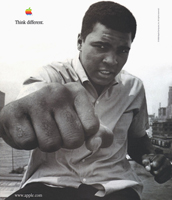
Quite a controversy blew in on Curation Revolution on Scoop.it last week. I didn’t start this controversy (lol). The “branding as a possible waste of time” controversy was started by Brian Millar, the strategy director at Sense Worldwide on Fast Company. Brian’s two part series took cherished brands and what passes as “branding” to task.
I decided to reverse my reading order here and lead with Brian’s first article titled: Branding Talk Isn’t Helping Your Company Here Is What Should Replace, followed by my reactions to Is Branding An Artifact of the Past. Since Brian’s second title feels like the real question, so I used it in question form to umbrella both Brian’s posts and my notes. I added What To Do About Branding, today.
Marty’s Notes On Branding Is An Artifact of the Past
I appreciate a genius marketer helping me rethink cherished assumptions. Brian is onto something too. Brands, like everything else, are changing. When consumers are willing to showroom a product in Target and buy it from Amazon whose brand is winning? Is the concept of brand misaligned as Millar suggests?
Millar is making an important point. Brands in an interconnected, conversationally rich, always on world where you can know and participate in anything and where time and space collapse are different. Our post-Moore’s Law and “Internet Everything” time is different. When I was growing up there were four TV channels and shows such as Beaver Cleaver was considered exciting television. Try watching a single episode of Leave It To Beaver now to know how painful time’s whip can be (lol).
I think Millar has stumbled onto a larger marketing myth, a myth that may have pulled wool over marketers’ eyes for a hundred years. Brands seemed like our organizing force then because there were so few organizing forces. Now that we have forces forming, exerting influence and disbanding in moments, at least compared to Beaver Cleaver’s time, brands may not be the STRONG FORCE we have perceived them to be.
My showrooming example is telling. If I’m on a phone in Target buying an ipad for 30% less from Amazon is my brand loyalty to Apple, Amazon or Target? Neither since the “brand” loyalty is to saving 30%. If brands don’t rubber band or wrap consumer behavior as once thought what does? I’ve been fascinated with natural emergent systems such as ants and bees. Perhaps branding has been wrongly credited for genetic dances we all do, like bees, to describe where the food is hiding. We marketers, observing the dance, assigned credit to the last touch (the brand and branding) when attribution is more tribal, primordial and way upstream.
Let’s return to the Beav for a moment. Beaver Cleaver was a brand. He had goofy clothes some poor kid’s mom purchased, a goofy looking beanie hat and a lunch box that is probably a collectible now. Beaver was a “brand” in the sense that his image communicated complex messages fed by a weekly TV show when there wasn’t much competition. Beaver’s real branding was around classic American values. Beaver’s life had everything and everyone in their place. Beaver and his friends were well supported by money, friends and family. This dream-like world where no one gets sick or dies was always time stamped losing relevance almost as the show aired.
The Beaver didn’t last because his product didn’t have the legs or deep quality and excellence needed to continue to pivot, to create an ever widening, transparent and contemporary relevance. One day there were Beaver beanies and the next there wasn’t. After reading Millar’s articles one day there was a Coke and another day there may be no coke. Coke’s legs are looking short in the relevance department as Millar points out. I can hear the running of the bulls, angry bulls released by making such a statement. Let ’em run.
I appreciate Brian’s breaking my cherished brand glasses since these new broken glasses seem more capable of seeing into what is happening NOW. There are a lot of things happening all at once and I’m starting to move over to Millar’s thinkng that much of the process, promotional and product excellence we’ve labeled “branding” may be more related to real execution and less mythical things such as “branding”.
Great Einstein-like thought experiment in any case.
Marty & Therese Torris Notes
Branding Is An Artifact of the Past
Branding as shorthand feels more important now as the world collapses on our heads, but there is something gone forever in time. Perhaps brands haven’t changed as much as we have. This reminds me of returning to Harry C. Withers Elementary School after years away. What was once so large on return was so small. This shrinkage is what has happened to brands. Brands stayed the same size, but we’ve gotten infinitely larger. Smart, well thought out article with a position I never considered but that makes sense of our NOW.
Marty
Great comment from Therese Torris accurately summarizes my thinking before reading this article. After reading it I’m not as sure:
Therese Torris (Today, 5:55 AM):
I think brands are huge but they’re so many and so pervasive that we don’t perceive them any more. We swim in brands like fish in the ocean, we “Google”, we “send from my iPad”, we wear logos on our forehead… but thanks for the food for thoughts…
What To Do About Branding?
Google’s latest Panda and Penguin algorithm updates contain an important idea for branding and those who brand (us). Google’s strong stance is you create quality content and Google’s algorithm will work out who should win. It is easy to understand why Google is taking this stance. The explosion of UGC (user generated content) thanks to social networks changes what it means to be a “search engine”.
Brian’s articles could also have been titled Search Engines An Artifact of the Past. Search engines are over, done, gone. You may still use Google to search, millions do as I type this, but the concept of an all knowing God-like “engine” has been blown to tiny bits never to be reassembled. Once Google’s results started to float, when you see different results on the same keyword as me, then the concept of “search engine” was gone. Search engine implies static, absolute result sets. Static, everyone sees the same thing, results sets are gone (so important it warranted a repeat).
Rise of Social/Search and Branding
Here is where we enter tricky chicken or egg territory. Did the site I managed as a Director of Ecommerce receive more branded searches than anything because brands are what people look for or because our collective marketing system creates branded searches? A little bit of both ideas are in play.
Our commercial lives have been formed by “brands” and “branding”. If you are a baby boomer you’ve been exposed to millions of commercial messages many of them attached to shows such as Beaver Cleaver. Your (other boomers reading this) brand preferences are formed. What about if I had a son or daughter who would almost be about ready to have a family? What brands would my grandchildren imprint on and why, or how?
If I had the answer to such questions I could sit on a beach and have frosty beverages with little umbrellas brought to me at regular intervals. No one can know or predict who will win today’s and tomorrow’s brand battles. There are things we know including:
- “Traditional media” such as print and TV will have less brand imprint power.
- The ubiquitous mobile web will play a major role in forming “brand share”.
- Social/Search and its sister Social/Shopping are sure to play a major role too.
Given these known future realities marketing will be different. Here are tips on how to form a future “brand” or reposition ones you have:
- Discard cherished beliefs as Black Swan useless (read Taleb’s recently updated book for more).
- Check in on and revise company values (if needed).
- Create a “Blue Ocean” analysis of your business vertical (read Blue Ocean Strategy for more).
- Skeptical about Blue Oceans? Create detailed SWOTS (Strengths, Weaknesses, Opportunities and Threats) for you AND your 3 largest and most effective competitors.
- Create the single most important thing you want to accomplish in the next 90 days (read Mastering The Rockefeller Habits for more).
- Create Social, Local and Mobile SoLoMo campaigns radiating out from your location.
- Whatever you are spending on PPC double it.
- Whatever you are spending on inbound content marketing triple it.
Why SoLoMo?
The most controversial of my “branding” recommendations will be starting local. B2B brands will want to go national NOW. I don’t suggest starting small and local lightly and I suggest it for all companies who want to form “brands” built for the future.
Did you notice the lack of traditional “branding” campaigns in the list above? I fall in with Millar in the belief that branding is a byproduct of other marketing activities done with grace and greatness. Start small and local because doing so is thinking like an Internet marketer:
- Build a testing culture always looking to beat “control” creative.
- Create influential Key Performance Indicators (KPIs).
- Respond to what is happening in near real time via social networks.
- Build ever more powerful positive virtual cycles where KPIs increase exponentially.
Building ever more powerful positive virtual cycles is another way of saying more and more, faster and faster, better and better (read Internet Marketing’s Secret: More and More, Faster and Faster, Better and Better on ScentTrial Marketing for more on this key concept). You build brands for your children’s generation by being present, honest and values driven (read Grow by Stengel or Built to Last by Collins for more on importance of values).
In the end, the brands your children buy will be formed by actions (read How: Why How We Do Anything Means Everything by Dov Seidman for more on the importance of actions and processes consistent with values).
Hire An Internet Marketer, Ask For A “Brand” Audit
I’m an internet marketer and love this stuff, so you may think I am about to shill reasons for hiring Atlantic BT. A company consistently growing its top and bottom line greater than 25% before I arrived doesn’t need pushing. Atlantic BT is already a rocket ship well into an advanced growth phase. The “do we have a fit or a partnership” is a separate conversation best had in person and with people like Mike McTaggart and his business consulting team so I won’t discuss partnership here. This is not to say I don’t believe you and your company wouldn’t be better off with help from a group like ours or US. In fact, the most critical “branding” action you can take is hire someone like us, an agency who understands how to create future brands via Internet marketing’s 4Cs: Content, Community, Campaigns and Conversion.
Your story must be told online. More than that, your story must be told online consistent with your company’s values and its past (what many still think of as “branding”). These new Internet marketing tools such as Google Analytics, Magento and Social Media Marketing (Facebook and Twitter among others) are different and have two simultaneous audiences: People and Social/Search (Google).
You must hire a solid Internet marketing team to support until your team learns how to fish for themselves. The tricky part, as if the rest of this wasn’t tricky enough, is you can’t make your hiring decision based on what a vendor like Atlantic BT knows. The truth of Internet marketing I exposed in More and More, Faster and Faster and Better and Better is no one knows nothing (lol).
It is impossible to “know” what to do. What is happening NOW is Internet marketing’s only truth and NOW reinvents itself every second. Strange as it sounds, you must hire a partner based on their confessed ignorance. Look for processes not conclusions. If a firm tells you they can do anything Internet marketing related for X price and in Y time they are liars or worse fools and you should run for the door. Don’t confuse “impact” with process. Any competent company can share how much and how long it will take to develop a website. What no company can guarantee is will your new site matter. Testing and time are the only ways to know when or if something matters online and for who, and, to some degree, why. Everything else is Lies, Damn Lies and Statistics (lol).
Your best partner to create future brands believes in two things: Your Company Values and Wisdom of Crowds. All other “beliefs” are formed from the bedrock of these two ideas. This is not to discount the value of experience. Experience does lower creation costs and increase chances for a better result, but Black Swan’s exist and anyone who asserts their ability to, beyond any doubt, do anything is making it up. Better to judge a potential partner’s soul than their past accomplishments since a company’s soul is long lived and immutable (for the most part). When your soul feels like a match to theirs HIRE THEM.
To repeat a critical idea if a potential Internet marketing partner promises anything that seems too good to be true it is. “Too good to be true” tactics can do more than short term damage, they can harm your most valued possession – your online reputation. Google has an elephant’s memory, so go slow, discard cherished assumptions and hire your soul mates and create “brands” that will matter long into the future. Do that and whether we call it “branding” or “Internet marketing” is moot.
Follow and Get To Know Atlantic BT
The best first step in finding and hiring your Internet marketing soul mate is to follow them. Here are ways you can follow Atlantic BT:
@Atlantic BT on Twitter
Our Contact Us page
Join the over 1,300 who have Liked and Shared our Facebook Page
If you are ready to get started with a no obligation review of your needs, email Mike (Mike.McTaggart(at)Atlanticbt)dot(com).









